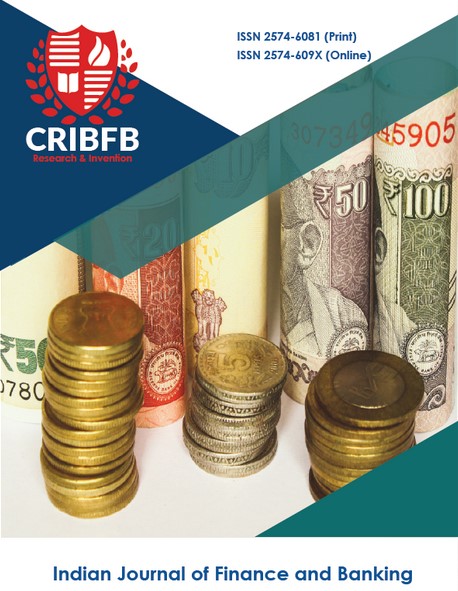AN EMPIRICAL STUDY ON IMPACT OF CREDIT RATING ON CREDIT RISK OF BANKS: A LITERATURE REVIEW
Main Article Content
Abstract
In the financial markets, for investors, lenders, and issuers, credit rating agencies (CRAs) have a critical part in reducing the asymmetry of information between various parties. Credit ratings allow us to recognize the credit impending of a region's individuals. The paper clearly describes the role played in the establishment of a nation by credit rating agencies; there is a rise in new start-ups as all investors are rated favorably. Banks are helping to recognize the investment position of India. The main aim of the study is to analyze the research gap on the impact of credit rating on credit risk with a review of the literature. The study briefly explains the research gap which helps to analyze the factors which are responsible for credit risk. The study analyzes the definitions of basic terms, the origin of credit rating agencies’ objectives, and the scope of the present study and the literature review by assessing the credit rating users and examined the consequence of credit rating agencies on the Indian financial markets. Based on the nationwide and worldwide literature it is found that if the credit history of the investors is good then their credit score would be better and positive. It would also be incredibly convenient to collect loans. Finally, it is concluded that there is a positive impact of Credit Rating on Credit Risk of banking sectors in India.
Downloads
Article Details
Section
How to Cite
References
Bhattacharyya, M. (2009). A Study of Issuer Rating Service with an Appraisal of ICRA? Rating Model. Indian Journal of Accounting, 39(2), 53-60.
Bheemanagauda. (2008, November). Working of Credit Rating Agencies in India- A study (Master thesis, Kuvempu University, Jnanasahyadri, Shankaraghatta, (Shivamogga District, Karnataka). Retrieved from http://hdl.handle.net/10603/85373
Bolton, P., Freixas, X., & Shapiro, J. (2012). The credit ratings game. The Journal of Finance, 67(1), 85-111. https://doi.org/10.1111/j.1540-6261.2011.01708.x
Bratanovic., S. B., & Greuning, H. V. (2000). Analyzing Banking Risk. Working Paper. The World Bank. Washington D.C. Retrieved fromhttp://hdl.handle.net/10986/33860
Caprio, G., & Klingebiel, D. (2000). Bank insolvencies: Cross-country experience. Working Paper. The World Bank. Washington D.C. Retrieved from https://econpapers.repec.org/RePEc:wbk:wbrwps:1620
Elkhoury, M. (2009). Credit rating agencies and their potential impact on developing countries. UNCTD Compendium on Debt Sustainability, 165-180. Retrieved from https://unctad.org/en/docs/osgdp20081_en.pdf
Hassan, O. G., & Barrell, R. (2013). Accounting for the determinants of banks credit ratings. Economics and fiancé. Working paper series. Retrieved from http://www.brunel.ac.uk/economices
Kumar, K. V., & Rao, S. H. (2012). Credit Rating-Role in Modern Financial System. International Journal of Marketing, Financial Services & Management Research, 1(8), 126-138.
Lynch, T. E. (2009). Deeply Persistently Conflicted: Credit Rating Agencies in the Current Regulatory Environment. Case Western Reserve Law Review, 59(2), 227. Retrieved fromhttps://scholarlycommons.law.case.edu/caselrev/vol59/iss2/3
Matthies, A. B. (2013). Empirical Research on Corporate Credit Ratings: A Literature Review. SFB 649 Discussion Paper. Retrieved from http://hdl.handle.net/10419/79580
Partnoy, F. (2017). What's (still) wrong with credit ratings. Wash. L. Rev., 92, 1407. Retrieved from https://digitalcommons.law.uw.edu/wlr/vol92/iss3/6
Poon, W. P., & Firth, M. (2005). Are unsolicited credit ratings lower? International evidence from bank ratings. Journal of Business Finance & Accounting, 32(9‐10), 1741-1771. Retrieved from https://doi.org/10.1111/j.0306-686X.2005.00646.x
Reddy, B. R., & Gowda, M. R. (2008). Some aspects of credit rating: A case study. Management Accountant-Calcutta-, 43(6), 436.
Saluja, M. S., & Drolia, A. (2015). Effect of Credit Rating on Cash Holding and Earning Momentum of Indian Companies. Indian Journal of Applied Research, 5(2), 98-100.
Sinkey, J. F., & Greenawalt, M. B. (1991). Loan-loss experience and risk-taking behavior at large commercial banks. Journal of Financial Services Research, 5(1), 43-59. https://doi.org/10.1007/BF00127083
Tang, T. T. (2009). Information asymmetry and firms’ credit market access: Evidence from Moody's credit rating format refinement. Journal of financial economics, 93(2), 325-351. https://doi.org/10.1016/j.jfineco.2008.07.007




